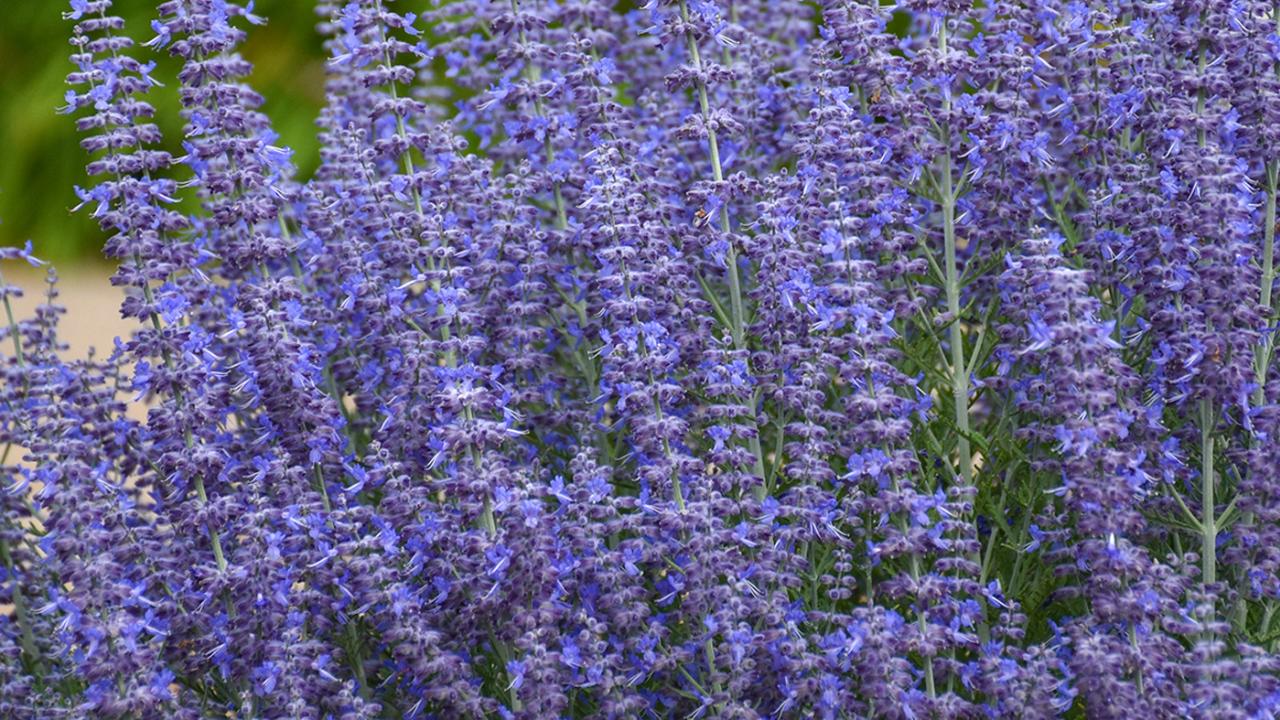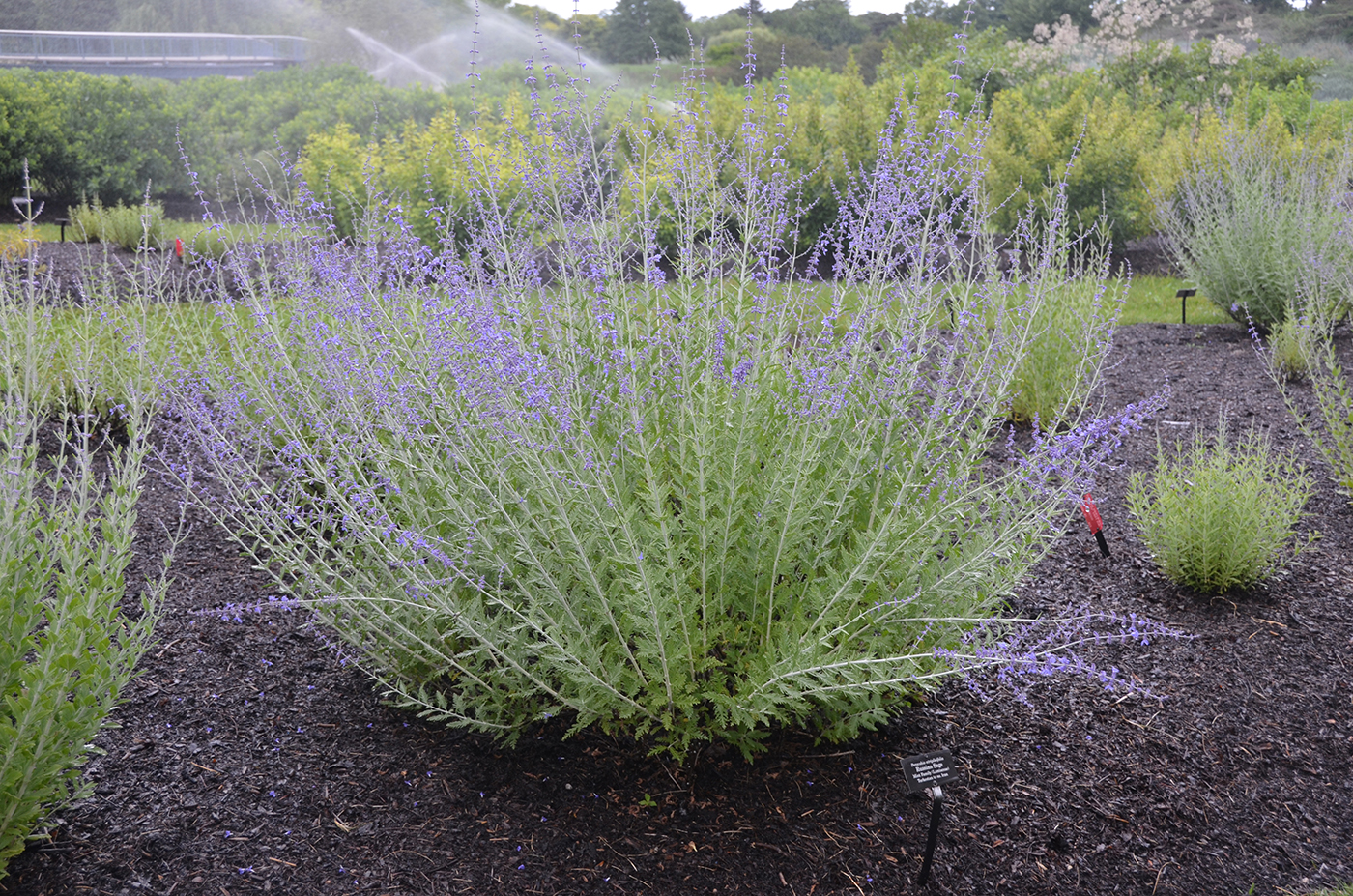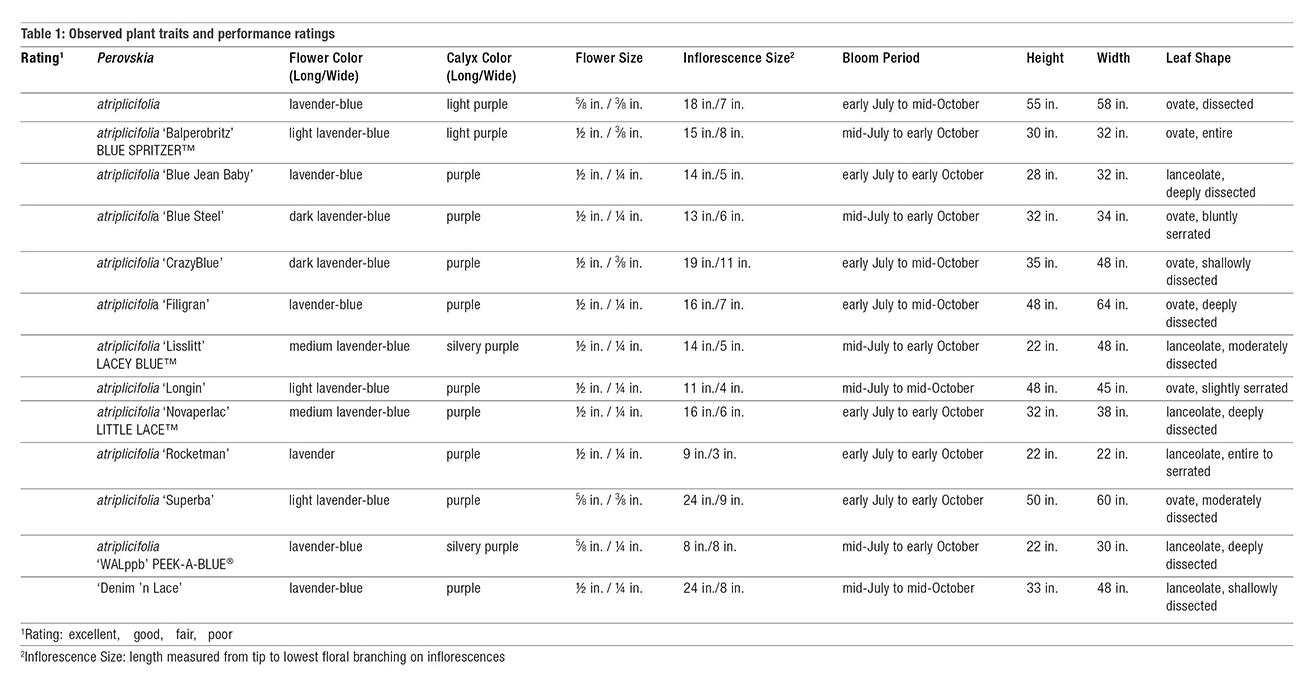

An Evaluation Study of Russian Sage Cultivars
An Evaluation Study of Russian Sage Cultivars
(Perovskia spp.) | Issue 46 2020
Richard G. Hawke, Plant Evaluation Manager and Associate Scientist

Perovskia atriplicifolia
Russian sage is a popular garden and landscape plant valued for its lavender-blue flowers over a generous bloom period, silvery green leaves, shrubby habit, and companionability with many other plants. Long cultivated as an herbaceous perennial—it was introduced into the United Kingdom in the early twentieth century—Russian sage is technically a subshrub, which is a plant with a woody base that produces herbaceous stems during the growing season. Incidentally, in spite of its common name, Russian sage is not native to Russia.
Perovskia spp. is a member of the mint family (Lamiaceae) with seven species native to southwestern and central Asia. A number of cultivars attributed to Russian sage (P. atriplicifolia) are widely cultivated; another species, Caspian sage (P. abrotanoides) is less common in gardens. However, botanical traits of P. abrotanoides—most notably bipinnately dissected leaves and narrow flower panicles—are present in some cultivars of P. atriplicifolia, leading to the presumption that these cultivars may be hybrids between the two species. Recent taxonomic developments subsumed Perovskia into the genus Salvia, and P. atriplicifolia specifically, has been renamed Salvia yangii.
The cultivars of Russian sage offer up a subtle variation in flower colors compared to perennials such as autumn sage (Salvia greggii) and garden phlox (Phlox paniculata) that come in a rich variety of colors. Shades of lavender-blue prevail, with slight differences in flower and calyx colors noted among the cultivars. The small bilabiate flowers—typically half an inch long and one-quarter inch wide—feature broad, four-lobed upper lips and narrow lower lips. Flowers open randomly and sporadically from early July into October in Chicago, and although bountiful over the entire season, they are not open in great enough quantities at any time to be truly impactful on their own. Instead, the fuzzy purple calyces that nestle the flowers command the floral display; calyces are colorful before flowers open and persist long after the flowers have dropped. By late summer to early autumn, the fading calyces begin abscising and the ghostly skeletons that remain, together with the silvery stems, provide some ornamental appeal in the winter months.
Like other mint relatives, Russian sage flowers are arranged in whorls or verticillasters along the gray-white downy inflorescent branches. The shape and density of the many-flowered terminal inflorescences influence the floral display; inflorescences range from airy, branching panicles to more compact, crowded panicles. The color show is more intense on cultivars that feature closely spaced flowers such as ‘Denim ’n Lace’ and ‘Blue Jean Baby’; conversely, color is more diffused—often appearing lighter—on cultivars with widely spaced verticillasters such as LITTLE LACE™ and BLUE SPRITZER™ .
In a similar manner to the inflorescences, the foliage of Perovskia atriplicifolia and P. abrotanoides are distinct from each other. The ovate-oblong leaves of P. atriplicifolia are entire or sparsely to bluntly toothed, whereas the ovate leaves of P. abrotanoides are bipinnatifid, or twice pinnately cleft. The hybrid origin of commercially available Russian sages in the United States is suggested by the foliar traits of the cultivars, which vary from ovate to lanceolate with entire, serrate, or deeply incised margins. The silvery to gray-green leaves range from 1 to 2 inches long and are pungently aromatic when crushed. Like the inflorescences, the square stems are covered in grayish white hairs. Plant sizes and habits vary among the cultivars. Older cultivars such as ‘Filigran’ and ‘Superba’ tend to be large—4 feet or taller—loose in habit, and may develop lax to floppy stems even in full sun. Newer cultivars such as ‘Blue Jean Baby’ and ‘Rocketman’ have sturdy, compact habits, and are typically less than 3 feet tall.
For best growth and performance, Russian sage requires full sun and good soil drainage, which is essential in surviving wet winters. Russian sage will flower in partial shade but the habit will be lax to sprawling. Warm summers are necessary for strong flower production; however, Russian sage does not like overly hot, humid climates. Drought tolerance, deer resistance, and low maintenance are sustainable aspects of Russian sage. Deadheading is unnecessary and does not increase flower production or lengthen the bloom period. Cut all stems down to at least 6 inches in the spring, although stems are often killed to the snowline or lower in cold climates. Regrowth in the spring will be weaker in wet conditions. Russian sage is relatively disease-free, although fungal leaf spot and stem canker disease can be problems.
In gardens and landscapes, Russian sage is used to great effect in large masses or as specimen plants. Russian sage is a perfect companion for fine-textured grasses such as prairie dropseed (Sporobolus heterolepis) and fountain grass (Pennisetum alopecuroides), while its lacy foliage contrasts beautifully with the bolder leaves of garden phloxes (Phlox paniculata), coneflowers (Echinacea spp.), and beardtongues (Penstemon digitalis). The silvery leaves are a fantastic foil for the vibrantly colored flowers of other perennials and the lavender-blue blossoms nicely complement pink, yellow, orange, purple, and deeper blue flowers. At the Chicago Botanic Garden, sweeps of Perovskia atriplicifolia and Coreopsis verticillata ‘Golden Shower’ make an inspired pairing on Evening Island—a simple, yet brilliant contrast of color, texture, and form. Russian sages are pollinator-friendly and attract bees, butterflies, and hummingbirds. Perovskia atriplicifolia was honored as the Perennial Plant of the Year® in 1995; an award recognizing its garden merits and reliability.
List of Sections
The Evaluation Study
The Performance Report
Top-rated Russian Sages
Summary and Performance Chart
References
Armitage, A.M. 2020. Herbaceous Perennial Plants, Fourth Edition. Champaign, IL: Stipes Publishing L.L.C.
Phillips, E. and C.C. Burrell. 2004. Rodale’s Illustrated Encyclopedia of Perennials. Emmaus, PA: Rodale Inc.
Royal Horticultural Society, England. rhs.org.uk.
Cover photo: Perovskia atriplicifolia 'Rocketman' © Walters Gardens, Inc.













